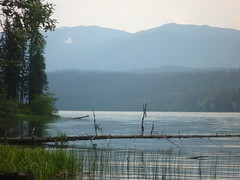 As we brace our way into a head wind along the east side of the fjord-like Isaac Lake, I soak up the view of this vast, deep green, ocean-like expanse that runs L-shape for nearly 38 kilometres, forming nearly half of the total circuit. The rock we paddle past is primarily calcareous phyllite, limestone and quartzite, typical of the type locality for this group and considered upper Proterozoic (Young, 1969), the time in our geologic history between the first algae and the first multicellular animals.
As we brace our way into a head wind along the east side of the fjord-like Isaac Lake, I soak up the view of this vast, deep green, ocean-like expanse that runs L-shape for nearly 38 kilometres, forming nearly half of the total circuit. The rock we paddle past is primarily calcareous phyllite, limestone and quartzite, typical of the type locality for this group and considered upper Proterozoic (Young, 1969), the time in our geologic history between the first algae and the first multicellular animals.
It is striking how much this lake fits exactly how you might picture pristine wilderness paddling in your mind’s eye. No power boats, no city hum, just pure silence, broken only by the sound of my paddle pulling through the water and the occasional burst of glee from one of the park’s many songbirds.
We’ve chosen kayaks over the more-popular canoes for this journey, as I got to experience my first taste of the handling capabilities of a canoe last year in Valhalla Provincial Park. The raised sides acted like sails and kept us off course in all but the lightest conditions. This year, my colleagues and I are making our trek in low profile, Kevlar style. One single&one double kayak would be our faithful companions and mode of transport. They would also be briefly conscripted into service as a bear shield later in the trip.
Versatile those kayaks. <?xml:namespace prefix = o ns = "urn:schemas-microsoft-com:office:office" />
The area is home to a variety of plant life. Large sections of the forest floor are carpeted in the green and white of dogwood, a prolific ground cover we are lucky enough to see in full bloom. Moss, mushrooms and small wild flowers grown on every available surface. Yellow Lily line pathways and float in the cold, clear lake water.
Somewhere I read a suggestion to bring a bathing suit to the park, but at the moment, I cannot imagine lowering anything more than my paddle into these icy waters.






Comments